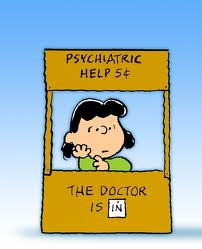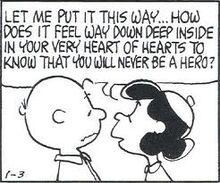The Doctor is IN
The twin colossi of Psychoanalysis, Sigmund Freud and Carl Jung, were two of a kind; bearded nineteenth century, middle European poop-obsessives. It is no surprise, therefore, that for many the standard image of the psychoanalyst is of a heavily accented pervert who assumes his own deviant sexual interest in his mother is universal. Had Jung and Freud been the only model of the Psychoanalyst it seems unlikely that the profession would ever have gained the high esteem that it holds today in modern USA. For that a more approachable, more wholesome, more American Psychoanalyst would be required. But who could fill the role?
Until the early 1900’s the only advice available to those several shots short of a piss-up was to pull themselves together and not make a scene (still the standard prescription for British sufferers of scrambled synapse syndrome). Following the publication of Freud’s masterpiece “Ihre Mutter” (Your Mom), however, the nation was awash with professionals expensively inviting you to blame yourself for your problems and to enrol yourself on a thirty month course of “talking therapy”. Who but the wealthy could afford bad advice at $100 an hour? The profession seemed about to founder when the late 1950s saw the arrival of Doctor Lucille Van Pelt, dispenser of bad advice for a mere five cents a session.
Despite a lack of formal qualifications beyond Grade School within years Van Pelt had diagnosed the mental issues of her fellow Peanuts co-stars and realised the pain behind the smiles of so many others who are paid to entertain us in the burgeoning cartoon industry. The Doctor was IN.
Charlie Brown
Raised largely in an absent-parent household Charles Brown first presented himself suffering from extreme alopecia (premature balding) in 1954. The obvious diagnosis was stress brought about by abandonment issues but Dr Lucy was never content to take note of an effect and diagnose a simple cause - such behaviour would have had her drummed out of the American Psychoanalysts Society in moments. She determined to completely analyse Brown’s many neuroses in the hope of showing him the deeper underlying roots of his problems and allowing him to confront his issues and cure himself - a revolutionary concept that allegedly had the A.P.S. take out a contract on her life.
She published her findings anonymously in two volumes to protect Brown’s identity. In the first, “Patient B and his imaginary Beagle”, she listed a number of related psychoses including:
- Malignant Anthropromorphism – “Patient B imbues his pet with abilities not only beyond that of an animal, but beyond that of most humans. In particular, he appears to subconsciously give abilities to the dog that he would most desire in himself, the better to berate himself for his relative failure. His beagle need only to wear sun-glasses in order to become “Joe Cool – life and soul of the party”, something Brown knows himself incapable of...."
“ ...an inveterate coward himself Brown believes that his dog is a World War I fighter ace....”
“...he believes that a neighbouring tree victimises him, deliberately “eating” his kite on every possible occasion – thereby relieving himself of any responsibility for his own lack of handling skills.”
“Most tellingly he has convinced himself that his dog would sooner talk to a strange, yellow bird than himself. This despite acknowledging that the bird itself is unable to talk. In this Brown is once again casting himself as the social outsider. Unable to come to terms with his celebrity he chooses instead to see himself as an eight year old social outcast.”
- Avoidant Personality Disorder – Van Pelt wrote that “Like most patients with APD Brown is anxious about everyday situations, constantly feels inadequate and inferior and has a fear that others perceive him that way. In addition, people diagnosed with Avoidant Personality Disorder have a small circle of close friends and are inept in social situations. Aside from his dog, Brown’s best friend, Linus, is another social reject whose own avowed best friend is a square of blue cotton flannel.”
- Body Anxiety – Van Pelt noted that despite nationally syndicated newspaper columns, television and movie appearances Brown could not accept that he was worthy of the attention of others. In her later book “Justified Self-Hatred” she states “... he has aroused the sexual interest of his two lesbian co-stars in Marcie and Peppermint Patty and yet still Brown dotes on a “Little Red-headed girl” no one else has ever seen. He simply cannot recognize his own success and so invents an unobtainable goal in order to preserve his familiar level of failure.”
- Hypnagogic Auditory Hallucination – Doctor Lucy noted that Brown was as unable to deal with his unusually high IQ as he was with his popularity. “As a child he recorded an SAT score that should have seen him lecturing at MIT, and yet his subconscious mind rendered every word of his teacher as a strange metallic, buzzing noise – the better to convince himself that he lacked the intelligence to understand the lessons she was attempting to impart."
Treatment
After over a decade of treatment, costing an estimated $83.60, Van Pelt determined that Brown’s problems boiled down to inverse trust issues: too willing to trust others no matter how frequently let down, Brown was unable to trust himself. As a result she pioneered the now common place “Field-goal Therapy”. In this innovative approach to psychological re-programming the patient chooses the person in whom he reposes the most trust as a reference post. He then allows that person to blatantly and repeatedly let him down until the patient begins to trust their own judgment more than that of the external reference.
Uniquely, Van Pelt was both analyst and reference post in this first version of field-goal therapy. Brown was urged to stand at fifteen paces and run towards her, ready to kick the football he knew she would whip away at the last moment. After landing on his back fifty eight times in succession Brown began to show signs of resentment and was heard to mutter the word “Rats!” Encouraged, Van Pelt repeated the therapy four hours a day for the next month, taking further encouragement from expressions of “Good Grief!”, “AUUUGHGH!” and “SIGH!”
The breakthrough came only a year into the treatment when after fracturing his sternum for the seventh time Brown uttered the words “Son of a Bitch” and was only a dislocated shoulder and three slipped discs prevented him from executing a subsequently stated threat to murder Van Pelt and keep her dismembered body in a kennel.
Linus Van Pelt
Despite the ethical issues created by treating her younger sibling, Van Pelt became the first Psychoanalyst to publish her theories concerning the use of a “Security Blanket” in the treatment of chronic neurotics. Linus, who had been confined to Saint Pilzapoppin Mental Institute, was able to use this emotional crutch to return to everyday life, albeit not without continuing thumb-sucking and a largely unacknowledged bed-wetting problem.
Unsurprisingly, Dr Lucy was not content to merely have given her brother a second chance at life but delved further into his mind in search of a way to remove the need for the security blanket. She was much taken by his rejection of his frequent admirer, Sally Brown, and his admiration of the older, authority figure, Miss Othmar but her eventual diagnosis was Schizotypal Personality Disorder.
In her groundbreaking diagnosis Van Pelt suggested that Linus’ perception of reality differed significantly from those around him. A course of strong anti-psychotics allowed him to hold down a low-demand job as a state legislator in Louisiana for more than a decade, a career he was forced to give up following his arrest for the murder and partial consumption of his boyfriend in 1985. Having convinced a jury that the actual offender was a third party known only as “The Great Pumpkin”, Linus was found not guilty and has lived in a monastery in Laos since 2005 regulating his psychoses only by regular meditation and ever-increasing doses of Ketamine.
Schroeder
Despite his successful acting career it had long been noted that Schroeder had some worrying autistic tendencies in addition to the delusional conceit that the notes his toy piano emitted hung tangibly in the air and could, when necessary, attack those who did not appreciate his playing. It was, however, his obsession with Ludwig van Beethoven that was all-consuming, causing him to ignore the crush the girl next-door had on him. As that girl was Van Pelt herself she felt able to attempt to confront this issue head-on.
Her first attempt at transferring Schroeder’s affections to herself involved classic iconoclasm, smashing his almost-worshipped bust of Beethoven in the hope that the loss would provoke a re-evaluation of the patient's life. However, this had overlooked Schroeder's OCD and hoarding- tendency. The broken Beethoven simply revealed that he had already purchased several closets of identical busts in case of zombie apocalypse. Attempts to destroy the piano resulted in repeated re-orderings and so Dr Lucy introduced Reverse-Psychology to the lexicon of American mental health professionals. She ceased her previous habit of leaning across the piano in admiration to little effect. Eventually she ceased scheduling appointments at all and moved away from the next-door property.
Days later Schroeder found himself unable to play, had proposed marriage and moved into Van Pelt’s New York apartment. Dr Lucy has long referred to her diagnosis of Dependent Personality Disorder as her biggest success – “It was clear he was crazy about me. Who wouldn’t be? He just needed to know how much he needed me. That’s why I lock him away in the basement three days a week!”
Calvin
Calvin was one of Van Pelt’s youngest patients and was first presented to the Doctor by his parents in 1979. Uniquely, there seemed little doubt that the boy was suffering from a disturbing combination of psychiatric problems.
Imbuing a toy with a personality is far from unusual in such a young child but Van Pelt was worried by the auditory and visual hallucinations that seemed to accompany what would otherwise have been harmless play. No parent really wishes to see their child talking to an inanimate object for hours at a time, much less losing complex philosophical arguments with it. That Calvin’s toy, a stuffed tiger he called Hobbes, repeatedly talked the boy into taking part in dangerous activities was enough to convince both them and Dr Lucy that Schizophrenia was a secure diagnosis.
However, the small child lived significant parts of his life as a number of differing alter-egos. Again, a vivid imagination in a child of six is often seen as a sign of intelligence. Calvin’s unnaturally wide vocabulary suggested that he was indeed far brighter than average but there was great concern at the days of not talking or eating following yet another of Spaceman Spiff’s crashes on an abandoned planet. Stupendous Man’s repeatedly unsuccessful attempts to fly from bedroom windows of the family home had seen several orthopedic emergencies but it was the Calvinosaurus attempt to trample the roof of the three storey house that had particularly alarmed his parents. Van Pelt diagnosed Dissociative Identity Disorder.
Calvin’s radically different multiple personalities were clearly a threat to his own health but sadly even Dr Lucy had not foreseen the threat to others caused by Tracer Bullet – a personality that seemed to be a 1930’s film noir detective. Like all Calvin’s multiple personalities Tracer Bullet was incompetent and he appears to have shot both Calvin's parents as they drove into the family garage, believing them to be Ma Barker and Knuckles McGraw escaping a bank-robbery.
Norville Rogers
Known to his friends as Shaggy, Norville Rogers presented to Dr Lucy in 1968 showing distinct signs of Paranoid Personality Disorder. Though he appeared to be able to trust a select group of friends, these friends seemed to be gripped by a version of Mass Hysteria in which they all believed that Roger's Great Dane could not only talk but suffered with a debilitating speech impediment. Rogers' paranoia most frequently manifested itself in his conviction that every town sheriff, every ghost-town curator and abandoned mine/funfair/paddle-steamer owner was a paranormal threat, and that their real identity could be revealed by tearing off their faces.
Closer examination of the case showed that for some years Rogers had been self-medicating with cannabis. Heroic over-consumption appeared to have boosted the economy of Canada by 1.3% of GDP and led to Chronic Munchie Syndrome. This leaving him unable to satisfy his hunger pangs without multilayer sandwiches up to five feet tall and multiple boxes of Scooby Snacks - later discovered to be popcorn laced with heroin.
That Rogers remained worryingly thin despite his daily consumption of more than 25,000 calories suggested to Van Pelt that drug-induced paranoia was not his only problem. Despite her best efforts, however, she could not convince her patient to face up to the issue most likely to kill him. It came as some comfort that, despite failing to cure Rogers, shortly after their last session, he made a guest appearance on Oprah to admit to suffering from Bulimia for decades, as well as finally coming clean about his passion for dressing up in women’s clothes, clown outfits, fireman’s uniforms, Halloween costumes etc, etc...
Rogers now works as a stunt double on the TV show "Man v Food."
See Also
| Featured version: 30 September 2014 | |
| This article has been featured on the main page. — You can vote for or nominate your favourite articles at Uncyclopedia:VFH. | |
This article was one of the Top 10 articles of 2014.
|








